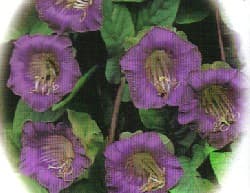How to Grow Cathedral Bell Flowers

Growing Annual Cathedral Bell Flowers in Your Home Flower Garden
Annual Cathedral Bells plants are an outstanding flower. Botanically known as “Cobaea Scandens”, they are popular for home gardens. And, they look great on fences, trellises, and in hanging baskets. Large, bell-shaped flowers will bloom from summer to fall. Young flowers are musk-scented. And mature flowers take on a honey scent. Read this guide on “How to Grow Cathedral Bell Flowers”. Then, buy some Catedral Bell seeds, and you’re on your way to growing a beautiful vining plant.
The plants have bright green leaves and cup-shaped flowers. Cathedral Bells are fast climbers. The buds begin with an unpleasant odor. However, the flowers open to give off a sweet, floral fragrance. Some varieties can grow over 20 feet in a season if supported by a trellis or a fence. Some people grow them in planters on balconies and decks, and let them trail down the outside of the deck fence. They are also popular in hanging baskets.
In addition to producing beautiful, pleasant scented blooms, the flowers attract hummingbirds.
Did you Know? Cathedral Bells seed packets are by far the most popular flower as favors for bridal showers and weddings.
Cathedral Bells Plant Specifications
Flower Colors: Colors include shades of orange, pink, rose, violet, and white.
Flowers Bloom: Summer through Fall.
Plant Height: Ten to twenty feet, depending upon variety.
Light Requirements: Full sun.
Ideal Soil pH: 6.1 – 6.5.
Hardiness Zone: 9 – 11. This versatile plant grows well in most hardiness zones.
Toxicity: It is not known to be toxic.
Native To: Mexico and other parts of Central America.
Plant Type: It’s actually a perennial vine that is most often grown as an annual.
Botanical Name: Cobaea Scandens
Other Names: Cup and Saucer Vine, air plant, life plant, miracle leaf, Goethe plant, and love bush.
Is the Cathedral Bells Plant Edible?
The plant is not known to be poisonous. However, we found no reference to the plant being used for human or animal consumption. With a lack of any information to the contrary, we recommend you not consume any part of this plant.
Cobaea Scandens Medicinal Uses
While no one eats any part of this plant, it has many medicinal applications. Cobaea Scandens has antibacterial, antiviral, antimicrobial, antifungal, antihistamine, and anaphylactic properties.
Medicinal uses include:
- It helps to lower high blood pressure.
- Reduce swelling.
- Looking to increase your energy level? Make a tea made from the stems and leaves.
- Use the tea to ease menstrual cramps.
- The tea can also clear your sinuses.
Light Requirements
For the best performance, give this plant full sunlight all day long. It needs energy for the sun to fuel its fast and steady growth.
With insufficient light the flowers may fail to bloom.
Cathedral Bells Plant Propagation
Cathedral Bells are grown from seeds. They require a long growing period. As a result, an indoor start is recommended for northern areas of the country. In areas with a long growing season, Cathedral Bells can be directly seeded into your flower garden.
Sow Cathedral Bell seeds early in the season and cover lightly with 1/8″ soil. Keep the soil moist during germination. We recommend heated germination mats for faster germination.
Transplant Cathedral Bell plants into your garden, after the last frost date for your area. Space plants 8-10″ apart. Provide something for them to grow on for maximum growth potential. They will tolerate a little crowding. If growing in hanging planters, space them a little closer.
Days to Germination: Cathedral Bell seeds germinate in 10 to 14 days.
How to Grow Cathedral Bell Flower Plants
Cathedral Bells tolerate a variety of soils. For maximum growth potential, provide a rich soil with plenty of organic matter. Soil should drain well. Add a general purpose fertilizer when planting them, then once a month after that.
Once your Cathedral Bells are established, they should grow well and vine out at a fast pace. Watering during dry periods is important to sustain fast growth and big, bright blooms.
In rich soil, additional fertilizer is not needed. However, an application of high phosphorous fertilizer just before the blooming period, will help to promote blooms.
Cathedral Bells are annuals. They will succumb to frost and freezes.
Pruning Needs
Like other plants, remove any dead, unsightly, or diseased leaves. Otherwise, keep your pruning shear on the shelf of your garden shed.
You do not need to deadhead the spent flower blooms. You won’t be able to reach many of them anyway.
Insects and Plant Disease
Cathedral Bells seldom have problems with insects and disease. Aphids and spider mites can be an occasional problem. If insect or disease problems occur, treat them early with organic or chemical insect repellents and fungicides.
Also see: Plant Problems – causes and cures.
Related Articles
People who read this article will also like:
Recipes – Cathedral Cookies
Please support our site. Shop for:
- rmmatthews100@hotmail.com
- 585-721-6528
- Rochester, NY
©1999-2024 GardenersNet.Com, All Rights Reserved

